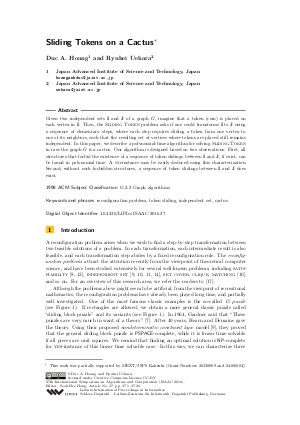Sliding Tokens on a Cactus
Authors Duc A. Hoang, Ryuhei Uehara
-
Part of:
Volume:
27th International Symposium on Algorithms and Computation (ISAAC 2016)
Part of: Series: Leibniz International Proceedings in Informatics (LIPIcs)
Part of: Conference: International Symposium on Algorithms and Computation (ISAAC) - License:
 Creative Commons Attribution 3.0 Unported license
Creative Commons Attribution 3.0 Unported license
- Publication Date: 2016-12-07
File

PDF
LIPIcs.ISAAC.2016.37.pdf
- Filesize: 0.74 MB
- 26 pages
Document Identifiers
Subject Classification
Keywords
- reconfiguration problem
- token sliding
- independent set
- cactus
Metrics
- Access Statistics
-
Total Accesses (updated on a weekly basis)
0Document
0Metadata
Abstract
Given two independent sets I and J of a graph G, imagine that a token (coin) is placed on each vertex in I. Then, the Sliding Token problem asks if one could transforms I to J using a sequence of elementary steps, where each step requires sliding a token from one vertex to one of its neighbors, such that the resulting set of vertices where tokens are placed still remains independent. In this paper, we describe a polynomial-time algorithm for solving Sliding Token in case the graph G is a cactus. Our algorithm is designed based on two observations. First, all structures that forbid the existence of a sequence of token slidings between I and J, if exist, can be found in polynomial time. A no-instance may be easily deduced using this characterization. Second, without such forbidden structures, a sequence of token slidings between I and J does exist.
Cite As Get BibTex
Duc A. Hoang and Ryuhei Uehara. Sliding Tokens on a Cactus. In 27th International Symposium on Algorithms and Computation (ISAAC 2016). Leibniz International Proceedings in Informatics (LIPIcs), Volume 64, pp. 37:1-37:26, Schloss Dagstuhl – Leibniz-Zentrum für Informatik (2016)
https://doi.org/10.4230/LIPIcs.ISAAC.2016.37
BibTex
@InProceedings{hoang_et_al:LIPIcs.ISAAC.2016.37,
author = {Hoang, Duc A. and Uehara, Ryuhei},
title = {{Sliding Tokens on a Cactus}},
booktitle = {27th International Symposium on Algorithms and Computation (ISAAC 2016)},
pages = {37:1--37:26},
series = {Leibniz International Proceedings in Informatics (LIPIcs)},
ISBN = {978-3-95977-026-2},
ISSN = {1868-8969},
year = {2016},
volume = {64},
editor = {Hong, Seok-Hee},
publisher = {Schloss Dagstuhl -- Leibniz-Zentrum f{\"u}r Informatik},
address = {Dagstuhl, Germany},
URL = {https://drops.dagstuhl.de/entities/document/10.4230/LIPIcs.ISAAC.2016.37},
URN = {urn:nbn:de:0030-drops-68074},
doi = {10.4230/LIPIcs.ISAAC.2016.37},
annote = {Keywords: reconfiguration problem, token sliding, independent set, cactus}
}
Author Details
References
- Marthe Bonamy and Nicolas Bousquet. Token sliding on chordal graphs. arXiv preprint, 2016. URL: http://arxiv.org/abs/1605.00442.
-
Paul Bonsma, Marcin Kamiński, and Marcin Wrochna. Reconfiguring independent sets in claw-free graphs. In R. Ravi and IngeLi Gørtz, editors, Algorithm Theory - SWAT 2014, volume 8503 of LNCS, pages 86-97. Springer, 2014.

-
Luis Cereceda, Jan van den Heuvel, and Matthew Johnson. Finding paths between 3-colorings. Journal of Graph Theory, 67(1):69-82, 2011.

-
Erik D. Demaine, Martin L. Demaine, Eli Fox-Epstein, Duc A. Hoang, Takehiro Ito, Hirotaka Ono, Yota Otachi, Ryuhei Uehara, and Takeshi Yamada. Linear-time algorithm for sliding tokens on trees. Theoretical Computer Science, 600:132-142, 2015.

-
Reinhard Diestel. Graph Theory, volume 173 of Graduate Texts in Mathematics. Springer, 4th edition, 2010.

-
Eli Fox-Epstein, Duc A. Hoang, Yota Otachi, and Ryuhei Uehara. Sliding token on bipartite permutation graphs. In Khaled Elbassioni and Kazuhisa Makino, editors, Algorithms and Computation - ISAAC 2015, volume 9472 of LNCS, pages 237-247. Springer, 2015.

-
Martin Gardner. The hypnotic fascination of sliding-block puzzles. Scientific American, 210(2):122, 1964.

-
Parikshit Gopalan, Phokion G. Kolaitis, Elitza Maneva, and Christos H. Papadimitriou. The connectivity of Boolean satisfiability: computational and structural dichotomies. SIAM Journal on Computing, 38(6):2330-2355, 2009.

-
Robert A. Hearn and Erik D. Demaine. PSPACE-completeness of sliding-block puzzles and other problems through the nondeterministic constraint logic model of computation. Theoretical Computer Science, 343(1):72-96, 2005.

-
Takehiro Ito, Erik D. Demaine, Nicholas J. A. Harvey, Christos H. Papadimitriou, Martha Sideri, Ryuhei Uehara, and Yushi Uno. On the complexity of reconfiguration problems. Theoretical Computer Science, 412(12):1054-1065, 2011.

-
Marcin Kamiński, Paul Medvedev, and Martin Milanič. Complexity of independent set reconfigurability problems. Theoretical Computer Science, 439:9-15, 2012.

-
Kazuhisa Makino, Suguru Tamaki, and Masaki Yamamoto. An exact algorithm for the Boolean connectivity problem for k-CNF. Theoretical Computer Science, 412(35):4613-4618, 2011.

-
Amer E. Mouawad, Naomi Nishimura, Vinayak Pathak, and Venkatesh Raman. Shortest reconfiguration paths in the solution space of Boolean formulas. In M. Magnús Halldórsson, Kazuo Iwama, Naoki Kobayashi, and Bettina Speckmann, editors, Automata, Languages, and Programming - ICALP 2015, volume 9134 of LNCS. Springer, 2015.

-
Amer E. Mouawad, Naomi Nishimura, Venkatesh Raman, Narges Simjour, and Akira Suzuki. On the parameterized complexity of reconfiguration problems. In Gregory Gutin and Stefan Szeider, editors, Parameterized and Exact Computation - IPEC 2013, volume 8246 of LNCS, pages 281-294. Springer, 2013.

-
Amer E. Mouawad, Naomi Nishimura, Venkatesh Raman, and Marcin Wrochna. Reconfiguration over tree decompositions. In Marek Cygan and Pinar Heggernes, editors, Parameterized and Exact Computation - IPEC 2014, volume 8894 of LNCS, pages 246-257. Springer, 2014.

-
Moritz Mühlenthaler. Degree-constrained subgraph reconfiguration is in P. In Giuseppe F. Italiano, Giovanni Pighizzini, and Donald T. Sannella, editors, Mathematical Foundations of Computer Science - MFCS 2015, volume 9235 of LNCS, pages 505-516. Springer, 2015.

-
Jan van den Heuvel. The complexity of change. In Simon R. Blackburn, Stefanie Gerke, and Mark Wildon, editors, Surveys in Combinatorics 2013, pages 127-160. Cambridge University Press, 2013.

-
Takeshi Yamada and Ryuhei Uehara. Shortest reconfiguration of sliding tokens on a caterpillar. In Mohammad Kaykobad and Rossella Petreschi, editors, Algorithms and Computation - WALCOM 2016, volume 9627 of LNCS, pages 236-248. Springer, 2016.

